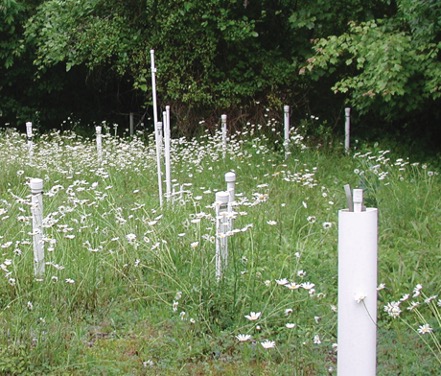
Thorgersen, M.P., .; J. Xue, E.L.W. Majumder, V.V. Trotter, X. Ge, F.L. Poole II, T.K. Owens, L.M. Lui, T.N. Nielsen, A.P. Arkin, A.M. Deutschbauer, G. Siuzdak, and M.W.W. Adams Deciphering microbial metal toxicity responses using RB-TnSeq and activity-based metabolomics. Applied and Environmental Microbiology 87 (21), e01037-21 (2021). [DOI]: 10.1128/AEM.01037-21] {PMID}:34432491 OSTI:1825256
Deciphering Microbial Metal Toxicity using RB-TnSeq and Activity-Based Metabolomics

Wellheads in the Bear Creek Valley watershed, at the Oak Ridge Field Research site on the U.S. Department of Energy’s Oak Ridge Reservation (TN) that are used for sampling groundwater. Wells are located in areas that span a contamination plume containing high concentrations of mixed metals that can impact the microbial community
High concentrations of toxic metals in an environment can limit the diversity of the microbial community present. In this study, microbe to metal interactions were investigated using two omic technologies on a metal resistant strain (Pantoea strain sp. MT58 (MT58)) found in a highly contaminated environment containing multiple toxic metals in the Bear Creek Valley watershed. The combined techniques were able to uncover important resistance factors used by the strain to defend against different metals from its environment and also determined areas of metabolism that were targets of metal toxicity.
Several novel metal to microbe interactions were uncovered by this research including ways in which the metal resistant MT58 defends itself against aluminum, chromium and uranium. Additionally, it was discovered that aluminum toxicity targets the synthesis of the essential amino acid arginine leading to cell death. These new insights could help us understand how microbial communities are impacted by toxic metal contamination.
Studying microbial interactions with their native environment can lead to increased understanding of biological molecular mechanisms. In this manuscript, two ENIGMA developed global techniques, RB-TnSeq and activity metabolomics, were successfully used to probe interactions between a metal resistant microorganism, MT58, and metals contaminating an Oak Ridge Reservation site where the organism can be located. A number of novel metal to microbe interactions were uncovered including aluminum toxicity targeting arginine synthesis, chromium affecting sulfate uptake, and lipopolysaccharides protecting MT58 from uranium stress. Using multi-omic approaches is an effective way to further our understanding of microbial interactions with their environment.
Contact
Mike Adams <adamsm@uga.edu>
University of Georgia – Athens
